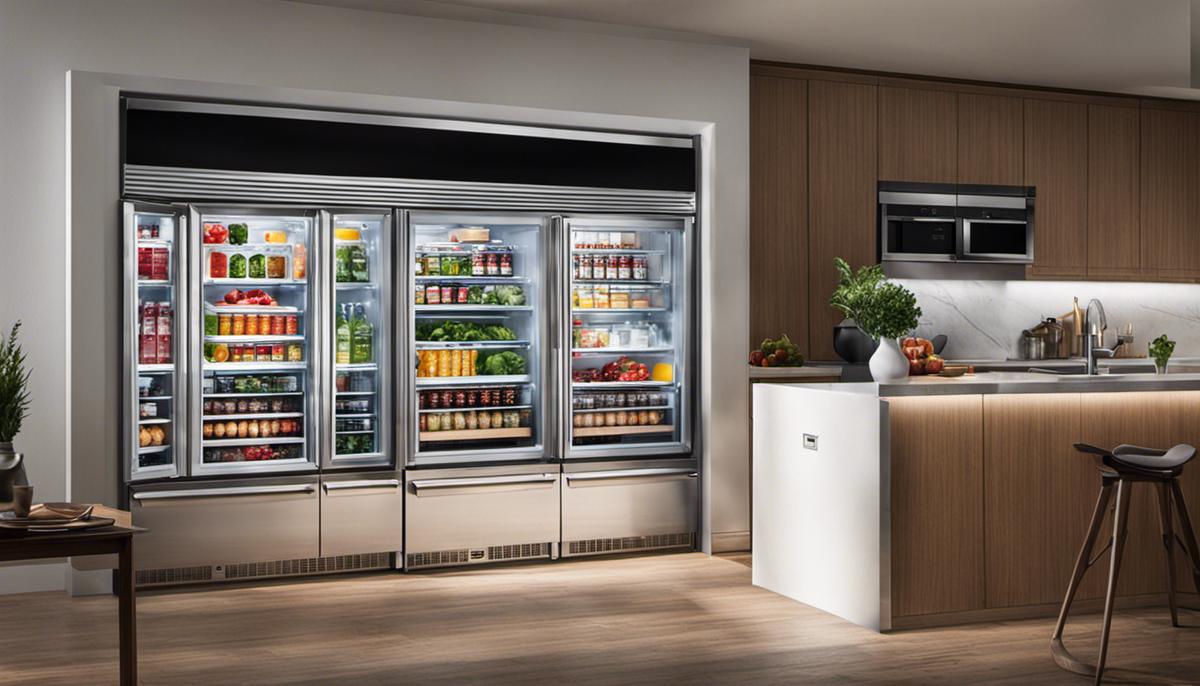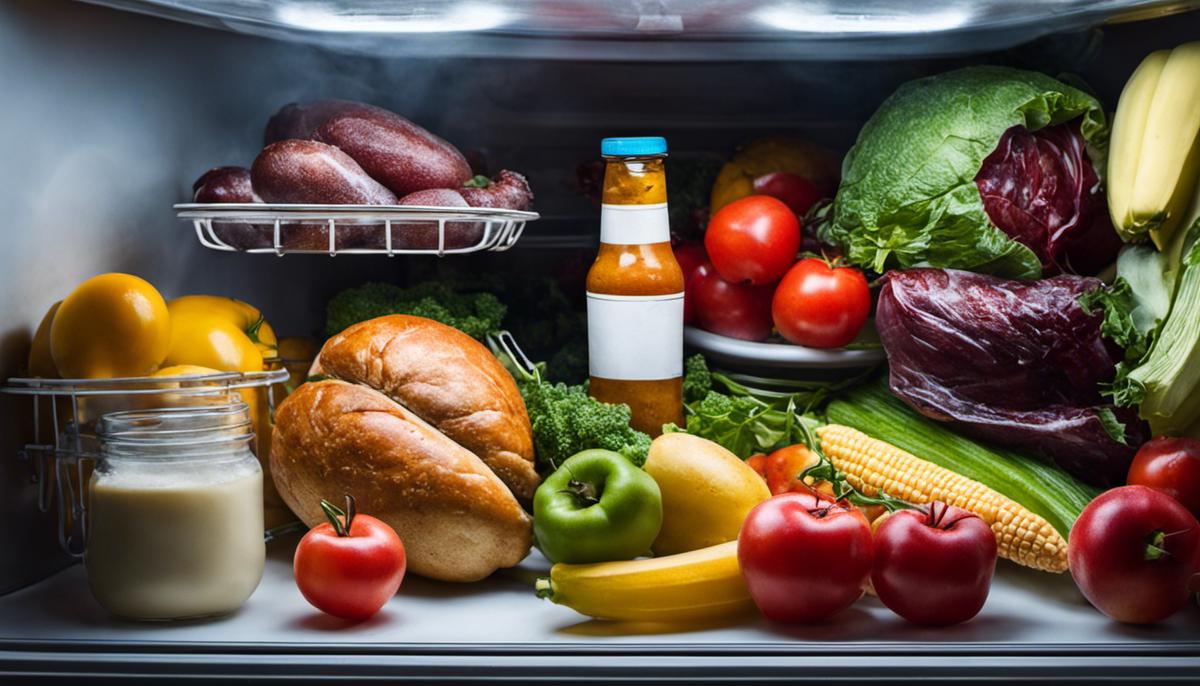Navigating the complexities of food safety is paramount in our daily life. It becomes even more challenging in the face of an event like a power outage, where the shelf life of food can quickly come into question. This comprehensive piece addresses key areas such as understanding food storage temperatures, managing food effectively during a power outage and assessing the safety of your food post-outage. With the knowledge of the ‘danger zone’ for food temperature and practical steps for managing food during a power outage, you will be equipped to handle these exigencies confidently and safely.
Understanding Food Temperatures
Understanding Critical Food Storage Temperatures
For optimal safety, the refrigerator should be set to hold foods at 40 degrees Fahrenheit or below, while a freezer should be set to 0 degrees. For utmost safety, make sure to check these temperatures periodically. An appliance thermometer can be a useful tool for ensuring your refrigerator and freezer are maintaining the correct temperatures.
Duration of Safe Storage at Room Temperature
Perishable food such as meat, poultry, seafood, milk, and leftovers should not be left at room temperature for more than two hours. This time decreases to just one hour if the ambient temperature is above 90 degrees Fahrenheit.
Non-perishable food that still appears safe due to good packaging shouldn’t be trusted after a power outage. Additionally, any opened packages, or those with broken seals, should be discarded even if they still seem fresh.
The Danger Zone – When Bacteria Multiplies
The temperature range from 40 degrees to 140 degrees Fahrenheit is known as the “Danger Zone”. At this range, bacteria can multiply most rapidly on foods leading to foodborne illnesses. Hence, it is of paramount importance to limit the time you keep food in this danger zone.
Refrigeration and Power Outage
During a power outage, keep the refrigerator and freezer doors closed as much as possible. Try not to open the refrigerator or freezer door unless necessary, to maintain as cold an interior temperature as possible.
Safe Handling of Food Post Power Outage
As a rule of thumb, when in doubt, throw it out. If there are any signs that food has begun to spoil in any way, it’s safer to discard it than risk foodborne illness.
Remember, the potentially harmful bacteria that causes most foodborne illnesses cannot be seen or smelled. That’s why temperature control and safe food handling are so important.
On a final note, perishable food disposed of during a power outage can often be claimed under homeowner’s insurance policies, so make sure to document any losses.

Managing Food during Power Outage
Preparation Before Power Outage
One of the biggest challenges during a power outage is preserving your food. Before an anticipated power failure, shift your refrigerator and freezer to the coldest settings. This helps to chill the contents at a quicker rate and extends the amount of time food remains cool when power is lost. Ensure the fridge and freezer are as full as possible; a full fridge retains cold temperatures better than an empty or nearly empty one. You should also have a supply of coolers, and ice or frozen gel packs on hand.
Immediate Action During Power Outage
Once a power outage occurs, avoid opening the fridge and the freezer as much as possible. An unopened refrigerator can keep food cool for about 4 hours. Similarly, an unopened full freezer can keep its temperature for 48 hours or 24 hours if it’s half-full. To keep track of time, it is useful to note down the time the power cut happened.
If the power outage prolongs or if you suspect it might, transfer perishables from the fridge to the freezer to keep them at safe temperatures longer. Keep a thermometer in the fridge and freezer to monitor the temperature.
Using Ice and Coolers During Power Outage
If you have perishable food like meat, poultry, fish, eggs, and leftovers that have been above 40 degrees Fahrenheit for over 2 hours, discard them. Use your coolers and frozen gel packs or ice to extend the cooling period for these temperature-sensitive foods.
To optimally use your coolers, pack them tightly with food and ice, ensuring that much of the ice is distributed throughout the food rather than just sitting at the bottom of the cooler.
After the Power is Restored
Once power is restored, check the temperature of your freezer and fridge. If the freezer still contains ice crystals or its temperature is at 40 degrees Fahrenheit or below, the food is safe and can be refrozen. However, in the fridge, if perishable food has been above 40 degrees Fahrenheit for over 2 hours, dispose of it.
In the case of power restoration, remember your sense of smell and sight is not a good indicator of safety. When in doubt of a food item, it is better to dispose of it to avoid foodborne illnesses.
Precautions for Future Power Outages
To be better prepared for future power outages, consider purchasing a generator to power critical appliances like refrigerators. Always have sufficient canned food items and shelf-stable foods, that do not require refrigeration, as backups. Finally, ensure regular maintenance of your fridge and freezer to sustain optimal temperature control.

Assessing Food Safety Post-Outage
Evaluating the Duration of the Power Outage
A key factor in determining the safety of your food after a power outage is the duration of the outage itself. The general rule is that perishable food can remain safe in a closed, unpowered refrigerator for up to four hours. After that, the temperature can rise above 40 °F, the safe storage temperature set by the United States Department of Agriculture (USDA). If your freezer was full and remained closed during the power outage, its contents can stay frozen for 48 hours. If it was half-full, that time is reduced to 24 hours.
Checking the Temperature
If you suspect a long power outage, check the temperature of your fridge and freezer. Use an appliance thermometer to do this as most refrigerators have inbuilt thermometers. If the appliance’s internal temperature stayed at 40 °F or below, the food is safe to consume. For the freezer, the internal temperature should have remained at or below 0°F.
Identifying Signs of Spoilage
Sometimes, food may look or smell fine but is not safe to eat. Still, it’s important to perform visual and smell tests. Spoiled food can present changes in color, texture, and smell. If food has an unusual smell, color, or feel, don’t taste it to check for spoilage, throw it away.
Ice Crystals and Frozen Food
In your freezer, check for ice crystals on the food. If there are ice crystals present and the food is still at 40 °F or colder, it is safe to refreeze. However, the quality or taste may have been affected.
Precautions with Certain Food Items
Certain foods are more prone to spoiling quickly and could potentially lead to food poisoning. These items include meat, poultry, seafood, dairy products, and eggs. If in doubt, use the saying, “When in doubt, throw it out,” to err on the safe side.
What to Keep and What to Discard
After a prolonged power outage, use the following list as a guide on what to keep or discard:
- Keep: Hard cheeses, processed cheeses, butter, margarine, fresh fruits and vegetables, fruit juices, cranberry sauce, relishes, taco sauce, mustard, ketchup, olives, fresh herbs and spices, bread, rolls, cakes, muffins, tortillas, waffles, and pancakes.
- Discard: Meat, poultry, seafood, leftovers, pizza, soft and shredded cheeses, milk, eggs, custards, creamed veggies, baby formula, and open creamy dressings.
Please note that these are general guidelines. Always prioritize your health and safety over the value of the food. If you’re unsure, it’s better to discard the item.

The knowledge of optimal food storage temperatures, effective management of food during power outages, and post-outage food safety assessment aids in preventing food wastage and avoiding the risk of foodborne illnesses. Remember, the odour and visual appearance of food can be powerful indicators of its safety. When in doubt, the safest course is to throw it out. Equipped with the insights shared in this piece, you can now approach power outages with a newfound understanding and readiness, ensuring that when it comes to the food in your fridge, safety is never compromised.
